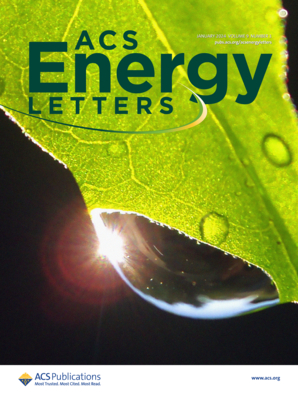Bismuth Confined in Thick Nitrogen-Doped Carbon for Durable Low-Temperature Potassium-Ion Batteries
IF 19.3
1区 材料科学
Q1 CHEMISTRY, PHYSICAL
引用次数: 0
Abstract
Bismuth is an alloying-type anode for potassium-ion batteries (PIBs) but faces the challenges of large volume expansion and sluggish potassiation/depotassiation kinetics. Herein, a composite of Bi nanoparticles confined in 10 nm-thick nitrogen-doped carbon layer (Bi@NC) exhibits notable rate capability (333 mAh g–1@30 A g–1) and cycling stability (290 mAh g–1@10 A g–1 after 2000 cycles) in K-storage. The high performance of Bi@NC is mainly ascribed to the encapsulation of Bi with thick N-doped carbon and a partial K+-solvent co-intercalation mechanism in the ether-based electrolyte, which enable the formation of a conductive c-K3Bi discharge product and stable solid electrolyte interphase, ensuring loss-free pulverization while avoiding high energy-consuming desolvation, leading to fast charge transfer kinetics even at low temperature. Accordingly, the PIB assembled with the Bi@NC anode and TiS2 cathode exhibits exceptional rate and cycling performance especially at −40 °C. This study provides an advanced Bi@NC anode for PIBs with exceptional low-temperature performance.

用于耐用低温钾离子电池的厚氮掺杂碳中的铋
铋是钾离子电池(PIBs)的合金型阳极,但面临着体积膨胀大和钾化/脱钾动力学缓慢的挑战。本文中,在10 nm厚的氮掺杂碳层(Bi@NC)中,铋纳米颗粒的复合材料在K-storage中表现出显著的倍率性能(333 mAh g - 1@30 ag - 1)和循环稳定性(2000次循环后290 mAh g - 1@10 ag - 1)。Bi@NC的高性能主要归功于Bi被厚n掺杂碳包裹,在醚基电解质中形成了部分K+-溶剂共插机制,使得c-K3Bi放电产物具有导电性和稳定的固体电解质界面相,保证了无损耗的粉化,同时避免了高能耗的脱溶,即使在低温下也能实现快速的电荷转移动力学。因此,与Bi@NC阳极和TiS2阴极组装的PIB在−40°C下表现出优异的速率和循环性能。本研究为pib提供了一种先进的Bi@NC阳极,具有优异的低温性能。
本文章由计算机程序翻译,如有差异,请以英文原文为准。
求助全文
约1分钟内获得全文
求助全文
来源期刊

ACS Energy Letters
Energy-Renewable Energy, Sustainability and the Environment
CiteScore
31.20
自引率
5.00%
发文量
469
审稿时长
1 months
期刊介绍:
ACS Energy Letters is a monthly journal that publishes papers reporting new scientific advances in energy research. The journal focuses on topics that are of interest to scientists working in the fundamental and applied sciences. Rapid publication is a central criterion for acceptance, and the journal is known for its quick publication times, with an average of 4-6 weeks from submission to web publication in As Soon As Publishable format.
ACS Energy Letters is ranked as the number one journal in the Web of Science Electrochemistry category. It also ranks within the top 10 journals for Physical Chemistry, Energy & Fuels, and Nanoscience & Nanotechnology.
The journal offers several types of articles, including Letters, Energy Express, Perspectives, Reviews, Editorials, Viewpoints and Energy Focus. Additionally, authors have the option to submit videos that summarize or support the information presented in a Perspective or Review article, which can be highlighted on the journal's website. ACS Energy Letters is abstracted and indexed in Chemical Abstracts Service/SciFinder, EBSCO-summon, PubMed, Web of Science, Scopus and Portico.
 求助内容:
求助内容: 应助结果提醒方式:
应助结果提醒方式:


